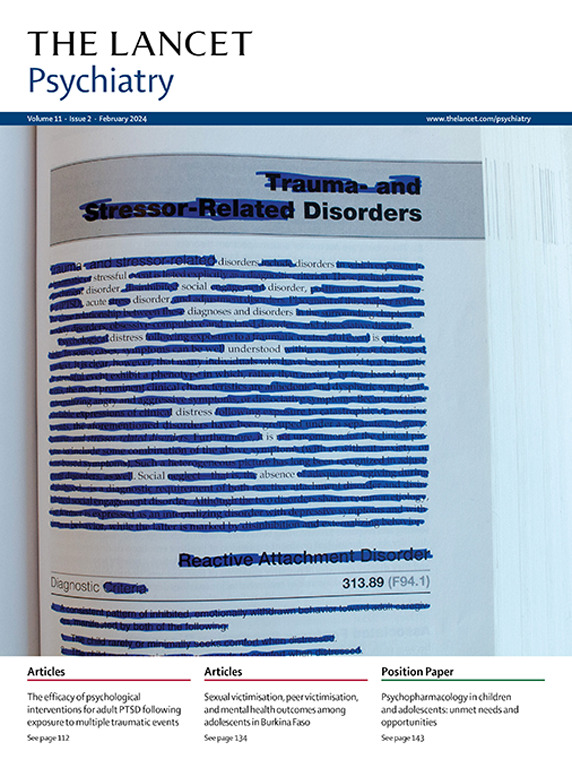Service coverage for major depressive disorder: estimated rates of minimally adequate treatment for 204 countries and territories in 2021
IF 30.8
1区 医学
Q1 PSYCHIATRY
引用次数: 0
Abstract
Background
Access to effective treatment for major depressive disorder remains limited and difficult to track across place and time. We analysed the available data on minimally adequate treatment (MAT) for major depressive disorder globally with the aim of providing a useful metric against which to monitor national responses to the growing public health burden imposed by major depressive disorder.Methods
MAT was defined as pharmacotherapy (1 month of medication, plus four visits to a medical doctor) or psychotherapy (eight visits with any professional). From existing reviews, we identified mental health surveys that assessed major depressive disorder within the general population as well as health service uptake by individuals with major depressive disorder. Data by ethnicity were not available. Estimates of MAT, antidepressant use, or use of any mental health service were extracted. The latter two estimates were adjusted to reflect likely MAT rates via a network meta-analysis. Adjusted MAT estimates were analysed via a Bayesian meta-regression using the Disease Modelling Meta-Regression (DisMod-MR 2.1) tool. This analysis estimated MAT coverage among people with major depressive disorder by age, sex, location, and year. Final MAT estimates were standardised by age and sex against the existing age and sex distribution of people with major depressive disorder globally. People with lived experience were involved in the design, preparation, interpretation, and writing of this manuscript.Findings
The analysed dataset included 145 estimates from 32 studies, covering 31 countries, 14 regions, and six super-regions. The proportion of people with major depressive disorder receiving MAT globally in 2021 was 9·1% (95% uncertainty interval 7·2–11·6), with 10·2% (8·2–13·1) of females and 7·2% (5·7–9·3) of males with major depressive disorder receiving MAT. MAT coverage was highest in high-income locations (27·0% [21·7–34·4]), with Australasia having the highest rate (29·2% [21·4–40·8]). MAT coverage was lowest in sub-Saharan Africa (2·0% [1·5–2·6]), within which western sub-Saharan Africa (1·8% [1·4–2·5]) had the lowest coverage. Seven countries (Australia, Belgium, Canada, Germany, the Netherlands, South Korea, and Sweden) were estimated to have MAT coverage exceeding 30%, while 90 countries were estimated to have coverage lower than 5%.Interpretation
Despite many gaps in the available data, estimates show that, globally, most individuals with major depressive disorder do not receive MAT. Services must improve to reach a global coverage that better meets the mental health needs of those with major depressive disorder. Urgent attention should be given to the scale-up of effective intervention strategies, especially in low-income and middle-income countries, as well as further research into better quality treatment options for major depressive disorder. We present a means by which the MAT gap for major depressive disorder can be quantified, to monitor and inform action by governments and international partners.Funding
Queensland Health and the Bill & Melinda Gates Foundation.重度抑郁障碍的服务覆盖范围:2021 年 204 个国家和地区的最低限度充分治疗估计比率
背景重度抑郁障碍患者获得有效治疗的机会仍然有限,而且难以跨地区和跨时间追踪。我们分析了全球范围内重度抑郁障碍最低限度充分治疗(MAT)的可用数据,旨在提供一个有用的衡量标准,用于监测各国应对重度抑郁障碍所带来的日益增长的公共卫生负担的情况。方法MAT被定义为药物治疗(1个月的药物治疗,外加4次医生就诊)或心理治疗(8次任何专业人士就诊)。从现有的综述中,我们找到了评估普通人群中重度抑郁障碍以及重度抑郁障碍患者接受医疗服务情况的心理健康调查。我们没有按种族划分的数据。我们提取了 MAT、抗抑郁药使用率或任何精神健康服务使用率的估计值。通过网络荟萃分析,对后两种估计值进行了调整,以反映可能的 MAT 使用率。通过使用疾病建模元回归(DisMod-MR 2.1)工具进行贝叶斯元回归,对调整后的 MAT 估计值进行分析。该分析按年龄、性别、地点和年份估算了重度抑郁障碍患者的 MAT 覆盖率。根据全球重度抑郁障碍患者现有的年龄和性别分布情况,按年龄和性别对 MAT 的最终估计值进行了标准化处理。有生活经验的人士参与了本手稿的设计、准备、解释和撰写。研究结果分析数据集包括来自 32 项研究的 145 个估计值,涵盖 31 个国家、14 个地区和 6 个超级地区。2021年全球接受MAT治疗的重度抑郁症患者比例为9-1%(95%不确定区间为7-2-11-6),其中10-2%(8-2-13-1)的女性重度抑郁症患者和7-2%(5-7-9-3)的男性重度抑郁症患者接受MAT治疗。在高收入地区,MAT 的覆盖率最高(27-0% [21-7-34-4]),其中澳大拉西亚的覆盖率最高(29-2% [21-4-40-8])。撒哈拉以南非洲地区的苯丙胺类兴奋剂覆盖率最低(2-0% [1-5-2-6]),其中撒哈拉以南非洲西部地区的覆盖率最低(1-8% [1-4-2-5])。据估计,7 个国家(澳大利亚、比利时、加拿大、德国、荷兰、韩国和瑞典)的 MAT 覆盖率超过 30%,而 90 个国家的覆盖率低于 5%。必须改善服务,使全球覆盖率更好地满足重度抑郁障碍患者的心理健康需求。当务之急是扩大有效干预策略的范围,尤其是在中低收入国家,并进一步研究更高质量的重度抑郁障碍治疗方案。我们提出了一种可以量化重度抑郁障碍治疗方案差距的方法,以便对各国政府和国际合作伙伴的行动进行监督和指导。
本文章由计算机程序翻译,如有差异,请以英文原文为准。
求助全文
约1分钟内获得全文
求助全文
来源期刊

Lancet Psychiatry
PSYCHIATRY-
CiteScore
58.30
自引率
0.90%
发文量
0
期刊介绍:
The Lancet Psychiatry is a globally renowned and trusted resource for groundbreaking research in the field of psychiatry. We specialize in publishing original studies that contribute to transforming and shedding light on important aspects of psychiatric practice. Our comprehensive coverage extends to diverse topics including psychopharmacology, psychotherapy, and psychosocial approaches that address psychiatric disorders throughout the lifespan. We aim to channel innovative treatments and examine the biological research that forms the foundation of such advancements. Our journal also explores novel service delivery methods and promotes fresh perspectives on mental illness, emphasizing the significant contributions of social psychiatry.
 求助内容:
求助内容: 应助结果提醒方式:
应助结果提醒方式:


